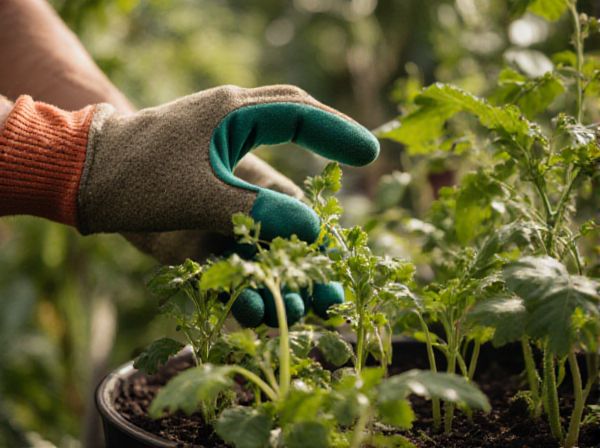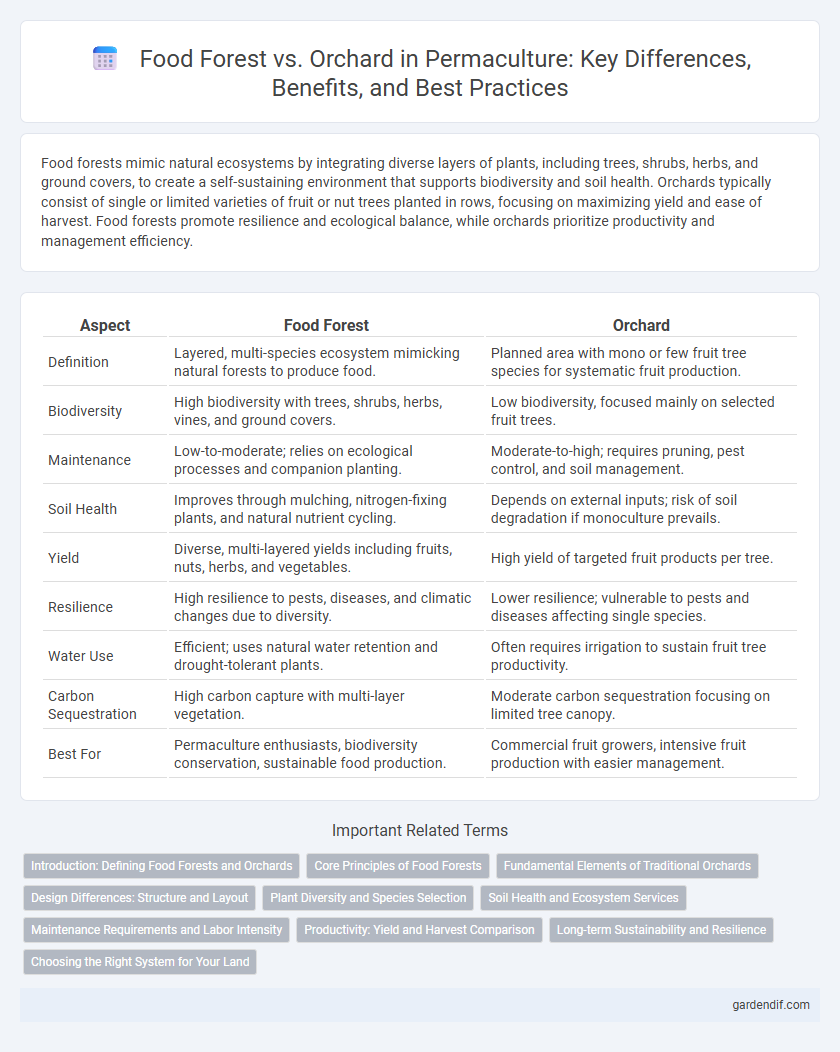
Food Forest vs Orchard Illustration
Food forests mimic natural ecosystems by integrating diverse layers of plants, including trees, shrubs, herbs, and ground covers, to create a self-sustaining environment that supports biodiversity and soil health. Orchards typically consist of single or limited varieties of fruit or nut trees planted in rows, focusing on maximizing yield and ease of harvest. Food forests promote resilience and ecological balance, while orchards prioritize productivity and management efficiency.
Table of Comparison
| Aspect | Food Forest | Orchard |
|---|---|---|
| Definition | Layered, multi-species ecosystem mimicking natural forests to produce food. | Planned area with mono or few fruit tree species for systematic fruit production. |
| Biodiversity | High biodiversity with trees, shrubs, herbs, vines, and ground covers. | Low biodiversity, focused mainly on selected fruit trees. |
| Maintenance | Low-to-moderate; relies on ecological processes and companion planting. | Moderate-to-high; requires pruning, pest control, and soil management. |
| Soil Health | Improves through mulching, nitrogen-fixing plants, and natural nutrient cycling. | Depends on external inputs; risk of soil degradation if monoculture prevails. |
| Yield | Diverse, multi-layered yields including fruits, nuts, herbs, and vegetables. | High yield of targeted fruit products per tree. |
| Resilience | High resilience to pests, diseases, and climatic changes due to diversity. | Lower resilience; vulnerable to pests and diseases affecting single species. |
| Water Use | Efficient; uses natural water retention and drought-tolerant plants. | Often requires irrigation to sustain fruit tree productivity. |
| Carbon Sequestration | High carbon capture with multi-layer vegetation. | Moderate carbon sequestration focusing on limited tree canopy. |
| Best For | Permaculture enthusiasts, biodiversity conservation, sustainable food production. | Commercial fruit growers, intensive fruit production with easier management. |
Introduction: Defining Food Forests and Orchards
Food forests emphasize diverse layers of edible plants that mimic natural ecosystems, promoting biodiversity and sustainability. Orchards primarily consist of single-species fruit or nut trees arranged for optimized production and ease of management. Understanding these foundational differences guides sustainable landscape design and agroforestry practices.
Core Principles of Food Forests
Food forests prioritize biodiversity, layering diverse plant species to create resilient ecosystems that mimic natural forests, whereas orchards typically focus on monoculture or limited varieties of fruit trees. Core principles of food forests include multi-strata planting, soil regeneration, and fostering symbiotic relationships between plants, animals, and microorganisms to enhance nutrient cycling and pest control. This holistic approach increases productivity and sustainability compared to the conventional orchard model.
Fundamental Elements of Traditional Orchards
Traditional orchards fundamentally consist of single-species tree rows spaced for mechanized pruning and harvesting, creating a simplified ecosystem with minimal understory vegetation. These orchards rely on regular inputs like fertilizers, pesticides, and irrigation to maintain tree health and maximize fruit production. In contrast, food forests integrate multi-layered plant strata, promoting biodiversity and natural nutrient cycling without intensive external resource use.
Design Differences: Structure and Layout
Food forests employ a multi-layered design that mimics natural ecosystems, incorporating diverse plants such as canopy trees, shrubs, ground covers, and root crops arranged in a polyculture system. Orchards typically feature a more uniform structure with rows or grids of single-species fruit trees, prioritizing ease of maintenance and harvest. The layout of a food forest emphasizes ecological functions and biodiversity, while an orchard focuses on maximizing fruit production efficiency.
Plant Diversity and Species Selection
Food forests feature multilayered plant diversity, combining trees, shrubs, herbs, and ground covers to mimic natural ecosystems, enhancing resilience and nutrient cycling. Orchards typically prioritize a single species or a few fruit tree varieties, optimizing yield but limiting biodiversity and ecological benefits. Species selection in food forests emphasizes complementary interactions and native varieties, while orchards focus on commercially valuable cultivars with consistent production.
Soil Health and Ecosystem Services
Food forests enhance soil health through multi-layered plant diversity, promoting nutrient cycling and organic matter accumulation, while orchards often prioritize monoculture crops with limited soil biodiversity. The diverse root systems and perennial vegetation in food forests improve water retention and support a robust microbial ecosystem, contributing to resilient soil structure. Ecosystem services in food forests include habitat provision, pollination support, and natural pest control, which are typically more complex and sustainable compared to the simpler ecological functions of traditional orchards.
Maintenance Requirements and Labor Intensity
Food forests require lower maintenance and labor intensity compared to orchards due to their diverse polyculture system mimicking natural ecosystems, which promotes self-sustaining nutrient cycles and pest control. Orchards demand consistent pruning, fertilizing, and pest management to maintain monoculture productivity, increasing time and effort investment. The multi-layered structure of food forests reduces soil erosion and weed competition, minimizing labor-intensive tasks.
Productivity: Yield and Harvest Comparison
Food forests produce diverse yields by mimicking natural ecosystems, combining layers of trees, shrubs, and ground plants to maximize space and year-round harvests. Orchards typically focus on a single crop species, offering higher immediate yields per tree but less variety and resilience. The mixed species in food forests improve soil health and pest control, often resulting in sustainable productivity over longer periods compared to monoculture orchards.
Long-term Sustainability and Resilience
Food forests mimic natural ecosystems by integrating diverse, multi-layered plant species that enhance soil health, increase biodiversity, and provide continuous yields, promoting long-term sustainability. Orchards typically focus on singular or limited fruit tree varieties, which can lead to soil depletion and greater vulnerability to pests and diseases, reducing overall resilience. The polyculture design of food forests supports ecosystem balance and resource efficiency, making them more adaptable to climate fluctuations and environmental stress.
Choosing the Right System for Your Land
Selecting between a food forest and an orchard depends on your land's size, biodiversity goals, and maintenance capacity. Food forests mimic natural ecosystems with layered plant diversity, boosting soil health and habitat resilience, ideal for regenerative permaculture design. Orchards focus on high-yield fruit tree production, optimizing space and harvest consistency but require more intensive management and less plant variety.
Food Forest vs Orchard Infographic

 gardendif.com
gardendif.com